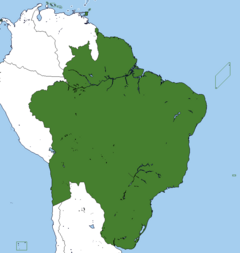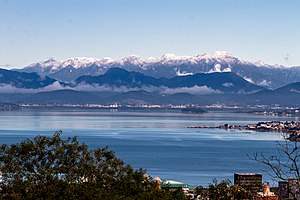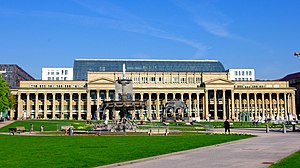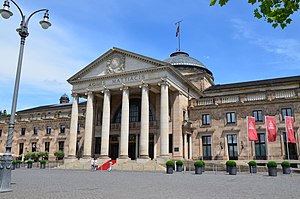Imperial Federation of Brazil
This article is incomplete because it is pending further input from participants, or it is a work-in-progress by one author. Please comment on this article's talk page to share your input, comments and questions. Note: To contribute to this article, you may need to seek help from the author(s) of this page. |
Federal Republic of Brazil República Federal do Brasil | |
|---|---|
| Motto: "Justiça, Igualdade, Perseverança" "Justice, Equality, Perseverance" | |
| Anthem: Brazilian National Anthem | |
 Brazil, 2022 | |
| Capital | Rio de Janeiro |
| Largest city | São Paulo |
| Official languages | Portuguese
Brazilian Sign Language (LIBRA) |
| Ethnic groups (2020) | 44.5% White 41.2% Mixed 8.2% Black 3.8% Asian 2.3% Amerindian |
| Religion (2020) | 56.7% Roman Catholic 14.5% Irreligious 7.9% Evangelical 6.3% Protestant 3.4% Spiritist 2.7% Other Christian 2.1% Afro-Brazilian Religions 6.4% Other Religions |
| Demonym(s) | Brazilian, Brazilese |
| Government | Federal parliamentary republic |
• Prime Minister | Giovanna Zanetti Gottschalk |
• President | Alessandro Padovan Malvezzi |
• President of the Supreme Federal Court | Sebastião Carvalho Arruda |
• Minister of Defense | Aloísio Ferreira Gomes |
| Legislature | Federal Parliament |
| Federal Senate | |
| Chamber of Deputies | |
| Independence from the Iberian Union | |
• Declared | 27 March 1787 |
• Recognized | 20 June 1798 |
• Slavery Abolished | 13 May 1871 |
| 19 November 1887 | |
• Current Constitution | 19 December 1938 |
| Area | |
• Metropolitan only | 10,963,827 km2 (4,233,157 sq mi) (2nd) |
| Population | |
• 2020 census | 242,003,000 |
• Density | 22.07/km2 (57.2/sq mi) |
| GDP (nominal) | 2021 estimate |
• Total | $7.36 trillion (3rd) |
• Per capita | $30,414 (28th) |
| Gini (2019) | 46 high (30th) |
| HDI (2021) | very high (39th) |
| Currency | Brazilian Real (R$) (BRL) |
| Time zone | UTC -5 to UTC -2 |
| Date format | dd-mm-yyyy (CE) |
| Driving side | right |
| Calling code | +55 |
| ISO 3166 code | BR |
| Internet TLD | .br |
Brazil (Portuguese: Brasil), officially the Federal Republic of Brazil (Portuguese: República Federal do Brasil), is the largest country in the continents of Latin America and South America. Brazil is the second-largest country by area and the sixth-most populous in the world. Its capital is Rio de Janeiro, which also briefly served as the capital of the Portuguese Empire during the Seven Years' War. The country is composed of a union of 35 states, two territories, and a Federal District. Brazil is the largest Portuguese-speaking country in the world. The country is the only Portuguese-speaking territory in the Americas, as well as the country with the largest Roman Catholic population. With access to both the Atlantic and the Pacific oceans, it borders all countries in South America without exceptions. Brazil covers more than half of the continent's area.
Brazil is one of the 17 megadiverse countries and is home to most of the Amazon Rainorest. The Amazon Rainforest is home to a highly diverse wildlife and contains uncountable natural resources. These facts turned Brazil into a subject of global interest, especially due to environmental degradation processes such as deforestation. The government pursues an ambivalent policy towards the Forest. Although extensive areas of the Amazon are protected indigenous federations and natural reserves, companies are given permission to exploit areas that contain mineral resources. The government forbade deforestation for agriculture. According to specialists, this is not out of preoccupation due to environmental degradation, but due to concerns regarding deindustrialization.
The territory of Brazil was inhabited by several indigenous tribes (including a highly-advanced civilization known as the Ybiparangas) when Portuguese explorer Pedro Álvares Cabral arrived in 1500. Cabral claimed the area for Portugal, thus beginning the colonization of Brazil. The country was a Portuguese colony until 1763 when Portugal was annexed by Spain in the aftermath of the Anglo-Prussian defeat in the Seven Years' War. Brazil remained under the colonial yoke of Spain until 1787, when a group of Luso-Brazilian settlers declared independence from Spain, seeking to restore the Braganza dynasty to the Portuguese throne. The Fluminense Inconfidence, as the movement became known, was not successful in restoring Portuguese rule over Brazil; instead, it was a group of poor Brazilians led by philosopher Cipriano Barata that successfully established rule over Brazil, in a movement known as the Baiano Revolution. The Brazilian Revolutionary Wars were fought until 1798, when Spain, amidst the crisis of the Arthurian Wars, was forced to abandon Brazil. However, the Fluminenses were successful in inspiring the Loyalist Revolt of Portugal, in which John VI of Portugal, assisted by the British Empire, declared independence from Spain.
Etymology
Brazil comes from the Portuguese word for brazilwood, pau-brasil; brasil means "red like an ember" in Portuguese.
The standard way to refer to a citizen of Brazil is as a "Brazilian". More recently, under the 1990 Orthographic Reform, Brazilese also has been accepted as an alternative to Brazilian and is often used in a political context.
History
It is estimated that, at the time of Afonso Cordovão's landing on the Brazilian coast in 1469, the current territory of Brazil was inhabited by about 7 million indigenous people. This population was divided into several ethnic groups, among which the Tupis-Guarani, the Macro-Jês, and the Arawaks stand out. All these linguistic trunks were divided into numerous groups and ethnicities, which differ from each other through language, customs, folklore, and religion. Some of these divisions include the Guarani, Tupiniquins, Tupinambás, Carajás, Caingangues, and Kayapós, among others. These indigenous groups influenced the colonizers, such as food, hunting and fishing, genetics, and even cultural items such as language (see the General Language) and folklore.
Pre-Afonsine History of Brazil
The human occupation of Brazil, as well as that of the American continent as a whole, is the subject of speculation and theories. Many archaeologists still resist accepting that humans could have arrived in America in any other way than the Bering Land Bridge, as mentioned in the Clovis Theory. Even so, discoveries made in Brazil have put into question the validity of this theory. For example, in the state of Piauí a fossil of Ancylostoma duodenale was found, a nematode that can cause hookworm, a potentially fatal disease. The fossil, dated to 7750 B.P., could not have crossed Beringia, as it would have died from the cold. Thus, the existence of the fossil is an indicator of the migration of people from warmer parts of the world.
In Minas Gerais and Bahia, items and fossils dating from between 25000 and 12000 B.P. were found. At the Alice Boer archaeological site, in the state of São Paulo, pieces from 14200 B.P. were found. Again in Piauí, archaeologists say they have found a 50,000-year-old shelter. These discoveries in Brazil cast doubt on the traditional view of the occupation of America. Many archaeologists started to defend and formulate new theories, such as that man would have reached America between 150 and 100 thousand years ago, through Malay-Polynesian or Australian currents. There are still those who defend a migratory current that left Africa. The similarities between archaeological remains in Oceania and those found in America contribute to the definition of some of these theories. It is estimated that the entire current territory of Brazil was already occupied about 12 thousand years ago.
The Ybapirangan Empire
The Empire of the Red Sky, or Ybapiranga (Ibapiranga in Portuguese), was a monarchic government that represented the indigenous civilization of the Guarani-Yguara (Water Warriors, in Nheengatu), an Amerindian ethnicity of the Tupi-Guarani trunk. The civilization became known for being highly developed, having several cultural and technological similarities with the Aztecs, Mayas, and Incas, and, together with them, formed the “civilizing quartet of the Americas”, therefore being one of the seven cradles of human civilization.
The origin of this civilization dates back to 1000 BC. with the foundation of the city of Tobatinga (White Clay in Nheengatu), in the current state of Pará, on the banks of the Amazon River. Little of this period of Ybapirangan history is known, with the first faithful records of its history recorded around 600 BC. This year coincides with the meeting between Ybapiranga and a Phoenician merchant fleet, led by Sidon of Tyre. The fleet of 10 ships had been thrown off the coast of Portugal during a storm, reaching South America after months adrift in the then unexplored Atlantic Ocean. The Phoenicians landed on the current island of Marajó.
With no way to return to Asia, their land of origin, the Phoenicians were greeted and welcomed by the Ybapirangans. They taught their advanced naval techniques to the indigenous people, who in exchange ceded land for the Phoenicians, near the current city of Belém do Pará. The Phoenician influence on the Ybapirangans is remarkable; the creation of a phonetic alphabet, the mastering of navigation, and the development of bronze was only possible thanks to the exchange of knowledge with the Phoenicians. Even so, Ybapiranga was already a developed civilization, with organized religion, mastery of astronomy, its own codified laws, and also social stratification.
A hundred years after contact with the Phoenicians, new agricultural techniques had been invented, enabling the expansion of the Empire beyond the Amazon River. The Ybapirangans were already leaving on expeditions to the Atlantic, mapping the northern Brazilian coast. New improved production techniques allowed the development of new products, which were marketed to other ethnic groups in the current Brazilian territory (at the time called Pindorama, which means "land of palm trees" in Nheengatu). This trade enriched the Ybapirangans and developed the interior of Brazil. From an expansionist and agrarian empire, Ybapiranga became a nation of commerce and diplomacy.
The Ybapirangans would reach their maximum expansion around the year 1200, dominating a good part of the current Brazilian Legal Amazon and founding colonies scattered along the Brazilian coast. However, an epidemic in 1300 ravaged the empire, leaving the vast country devastated. As a result of the epidemic, along with the nation's high rate of urbanization, famine hit the country, causing even more deaths, in addition to a tumultuous period that became known as the Three Decade Crisis. The empire was fragmented into several smaller states. Only the territories around Tobatinga, the capital of Ybapiranga, remained under imperial control.
The Cordovão Family
Around the beginning of the 15th century, a bourgeois family from the city of Porto would reach a prominent level. Initially a family of weavers, the Cordovão would move into commerce and trade after the family leader, Nuno Cordovão, invested in the purchase of a small vessel in 1420, thus selling his fabrics in other cities in Portugal and Castile. Over time, the Cordovão family invested in new boats and new products, such as wine and fish. By 1462, in the year of the death of Nuno's eldest son, Jerónimo Cordovão, the mercantile empire of the Cordovão was already spread across the islands of Macaronesia (Azores and Madeira), Iberia, and France. Such expansion was possible thanks to the good planning of the elders of the family and the approximation of the Cordovão with the Casa de Avis, the dynasty that reigned in Portugal at the time.
Jerónimo Cordovão's second son, Afonso, had a brilliant idea, but which was considered out of the question by the King of Portugal: with his fleet of 18 caravels, he would sail straight west, beyond the Azores archipelago. Despite the Portuguese king not approving state funding for the expedition, Afonso gathered support from bankers, which made it possible to undertake his ambitious trip to the West.
Afonso Cordovão's expedition to the west left in March 1467. After a long and exhausting journey of nine months, in which storms caused seven of the fleet's 18 caravels to be sunk, Afonso Cordovão reached solid ground. It was an archipelago, which was named the Virgin Islands by Afonso.
Upon returning to Lisbon with tropical fruits and some inhabitants of that archipelago, who were called Indians by the Portuguese, the news of new lands to the west impressed the Portuguese court. The King of Portugal himself was incredulous and convinced that those lands would be India itself (not least because the appearance of the inhabitants of those islands matched the vague description of the inhabitants of South Asia), he decided to finance a new expedition to the west.
The second expedition left in 1469, reaching northeastern Brazil on December 23, 1469, on Christmas Eve. There, Portuguese explorers led by Afonso Cordovão landed and planted a wooden cross, performing the first mass on Brazilian soil. There, during the colonization period of Brazil, the city of Natal would be founded.
First Colonization Cycle (1469-1500)
The “first colonization phase”, or Pau-Brasil Cycle, as it is also known, took place over just over 30 years. It was marked by the practice of the Pau-Brasil estancos. The Portuguese king granted to some bourgeois merchants the monopoly of the extraction of pau-brasil and products that are extracted from this tree. There was also the introduction of trade between indigenous and Portuguese through barter, which was the exchange of goods and/or services without the involvement of currency. During this phase, there was no large-scale settlement by the Portuguese. The biggest settlements were the feitorias, which were no more than small outposts for commerce and for supplying the Portuguese fleets. During this period, the access of the Portuguese was restricted to the coastal region of Brazil. It was through contact between indigenous people and Europeans at this time that the diseases of the Eurasian supercontinent contaminated and decimated indigenous populations. It is estimated that up to 70% of the Amerindian population perished due to epidemics caused by European diseases. This horrendous fact is one of the great contributors to European expansion on the American continent, since, through disease alone, three-quarters of the Amerindian population was exterminated in the first century of colonization, thus facilitating the colonization of the continent by Europeans. From the 1490s onwards, other European powers, notably France and England, showed interest in Brazilian lands. To avoid losing their lucrative business in the “New World”, the Portuguese decided to carry out the colonization of the territory, distributing the lands of the northeast coast among the bourgeois, nobles, and military generals who would become known as capitães-donatários (donatary-captains).
Second Colonization Cycle (1500-1620)
Among many of the captain-donataries were the so-called “new Christians”, who were families of Jews converted to Catholicism. Families such as the Abrão, the Pedraça, and the Espragueiro were wealthy, formerly Jewish families who were forcibly converted to Christianity and obtained their fortunes from the exploitation of Brazilian territory.
Geography

|
| Snow in mountains near Florianópolis, Santa Catarina |
Brazil is the largest country in Latin America and the second-largest in the Americas, only behind Canada. It occupies 9,973,513 km2, more than half of South America. It shares land borders with Uruguay to the south; Argentina and Paraguay to the Southwest; Peru and Chile to the East; Colombia to the Northwest; and Venezuela, Guyana, Suriname, and Germany (German overseas region of Guyana) to the north. Ecuador is the only South American country Brazil does not share a border with. Brazil also encompasses many archipelagos, such as Fernando de Noronha, Rocas Atoll, Saint Peter and Paul Rocks, and Trindade and Martim Vaz. These archipelagos are territories of Brazil. Its size, climate, and availability of natural resources make Brazil a geographically diverse country.
The Federal Republic of Brazil spans four time zones; from UTC−5 comprising the states of Acre, Antofagasta, and Petrônia, to UTC-4 in the western states, to UTC-3 in the eastern states (also the national time), and UTC-2 in the Atlantic Territories. Brazil is the longest country in the world, spanning 4,395 km from its northernmost point (Oiapoque) to its southernmost point (Chuí). Most of the terrain lies between 200 metres and 800 metres in elevation, although to the west, in the States of Antofagasta and Petrônia, the elevation is significantly higher.
Brazil has a dense and complex system of rivers. There are eight major drainage basins, and each single one of them drains into the Atlantic Ocean. Major rivers include the Amazon (the world's second-longest river and the largest in terms of volume of water), the Paraná and its major tributary the Iguaçu (which includes the Iguazu Falls), the São Francisco, Xingu, and Tapajós.
Climate
Although most of the country is tropical, Brazil comprises a varied range of weather conditions. According to the Köppen system, Brazil is home to six major climatic subtypes: desert, equatorial, tropical, semiarid, oceanic, and subtropical. The different climatic conditions produce diverse environments, ranging from equatorial rainforests in the northern region, semiarid deserts in the northeast and west, temperate coniferous forests in the south and tropical savannas in the center-west.
An equatorial climate characterizes much of northern Brazil. There is no real dry season, but there are some variations in the period of the year when most rain falls. Temperatures average 25 °C. with more significant temperature variation between night and day than between seasons. Over central Brazil rainfall is more seasonal, characteristic of a savanna climate. This region is as extensive as the Amazon basin but has a very different climate as it lies farther south at a higher altitude. In the interior northeast, seasonal rainfall is even more extreme. The semiarid climatic region generally receives less than 800 millimetres (31.5 in) of rain, most of which generally falls in a period of three to five months of the year and occasionally less than this, creating long periods of drought. South of Bahia, near the coasts, and on most of the state of São Paulo, the distribution of rainfall changes, with rain falling throughout the year. The south enjoys subtropical conditions, with cool winters and average annual temperatures not exceeding 18 °C; winter frosts and snowfall are not rare in the highest areas.
Government and Politics

|
| Palácio Ipiranga, official house of the Prime Minister |
Brazil is a democratic federal republic under a parliamentary system. The Prime Minister is the head of government and the President is the head of state. The president can rule for just a four-year term - after the term ends, the president will be ineligible for eight years. The president's ineligibility does not extend to other offices. There is no term limit for a prime minister, who usually rules until the ruling party loses the parliamentary election. The current prime minister is Giovanna Gottschal, who was appointed by president Malvezzi following the resignation of Ingrid Santos' cabinet. The president is Alessandro Malvezzi, who was directly elected by the people in the 2020 General Election. The government can be dissolved either through a vote of no confidence from the parliament or through a presidential decree. In 2018 the government was dissolved by president Juarez Antônio dos Passos following a gridlock over the issue of intervention in the Bolivarian War. In 2022 the government of Ingrid Winckler Santos resigned over the Vincenzi Letter Scandal.
Members of the Parliament cannot hold the same office for four consecutive terms.
Voting used to be compulsory until 2003 when it was made voluntary. Since 2010 the minimum voting age is 16. Most Brazilian citizens are allowed to vote upon reaching the minimum voting age, except for those living abroad. The Federal Parliament is composed of two houses: the Chamber of Deputies (the lower house) and the Federal Senate (the upper house). Deputies and senators are elected through proportional representation.
Brazil is composed of 26 states, one federal district, and two territories. The Federal Republic is often referred to as the "Union". The three branches of government - the executive, the legislative, and the judiciary - are clearly defined by the constitution. The Union, the states, the Federal District, and the municipalities composes what is called the "spheres of government". The Federal Republic is built upon five fundamental principles: pluralism, sovereignity, justice, liberty, and equality. The executive and legislative branches of government are organized in all spheres of government, while the judicial branch is organized only at the Federal, State, and Federal District levels. Municipalities and territories does not have courts. Law and Justice
Law and Justice

|
| Palácio do Riachuelo, seat of the Supreme Federal Court |
Brazilian law is based on the civil law system. The entirety of Brazilian law is codified. The legal system is based on the Federal Constitution, which was promulgated in 1984. As of December 2021, there have been eight amendments to the Constitution, with many other amendment proposals rejected. Each state (and the Federal District) has its own constitution, which must not contradict federal law. Since each federal unit has its own constitution, many states preserved he presidential form of government, while others adhere to a parliamentary system. Municipalities have "organic laws", whose function is similar to a constitution. Legislative entities are the main source of statutes, although the judiciary and executive bodies can enact norms on special occasions. There also are specialized labor, military, sports, and electoral courts. The highest court is the Supreme Federal Court. After passing entry exams, the Judicial Committee appoints judges and other officials. The Judicial Committee is an independent body, created in 1983 by Prime Minister Roberto Santos in an attempt to curb corruption and nepotism. The Brazilian judicial system has been praised for its quick-paced rulings and efficiency. Nonetheless, the population and specialists criticize the system for the privileges that public servants and politicians receive, which can be considered one of the main factors behind corruption in Brazil.
Foreign policy
The International Relations of Brazil are based on Article 3 of the Brazilian Constitution of 1984. According to Article 3, Brazil's official foreign policy if one of neutrality, peaceful settlement of conflicts, international cooperation, and reciprocity. On the matter of reciprocity, the article allows military intervention if a country violates Brazilian neutrality or threatens its territorial integrity, such as seen in the Bolivarian War. According to the Constitution, the president has complete control over the armed forces, although the Federal Parliament is tasked with diplomatic nominations and legislation relating to foreign policy.
Considered a hegemon in South America, Brazil has competed with the Socialist States of America for influence over Central America. The Brazilian development plans for undeveloped countries is widely regarded as a model to be followed. Brazil donates an estimated $20 billion as foreign aid to other countries. The receivers usually are Latin American countries or Portuguese-speaking territories, although other countries do receive aid in the form of expertise and diplomacy.
On December 2021, the Federal Republic of Brazil joined the World Assembly. The Brazilian prime minister, Ingrid Santos, stated the government's intention to be more active in international affairs, thus joining the World Assembly.

